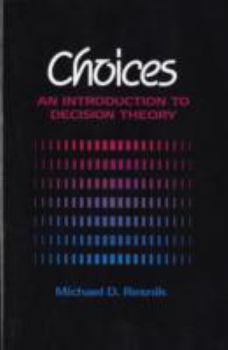Choices: An Introduction to Decision Theory
Select Format
Select Condition 
Book Overview
Book by Resnik, Michael This description may be from another edition of this product.
Format:Paperback
Language:English
ISBN:0816614407
ISBN13:9780816614400
Release Date:June 1987
Publisher:University of Minnesota Press
Length:240 Pages
Weight:0.05 lbs.
Dimensions:0.6" x 6.0" x 9.0"
Customer Reviews
2 ratings
Good course-accompanying textbook
Published by Thriftbooks.com User , 16 years ago
On its 216 or so pages, Resnik's book covers most themes of modern decision theory: decisions under uncertainty, under risk (with separate chapters on probability theory and the concepts of utility), game theory, and social choice theory. The book is clearly written and manages a good balance between the formal (probability calculus, techniques, proofs of major theorems) and the more philosophical discussions of underlying concepts and well-known paradoxes. Each of the six, 20-40 pages long chapters is divided into sections no longer than 3,4 pages, and each section closes with exercises (solutions not provided). Given about two sessions per chapter, the book is well suited as course material for undergraduate courses in philosophy, economics or statistics. This is also how I learned to know it. Returning to the book in preparation for an exam, I could not help to notice a few flaws. First, the book is now quite old (1987). It lacks a detailed discussion of preference relations and choice functions (e.g. Sen's conditions alpha, beta, gamma, the limit assumption), and there is also no part on backward induction in games that has become so fashionable. There are some excentricities, like that the "battle of the sexes" problem is rephrased in more "appropriate" terms, and it would be nice to have more historical background for the paradoxes (but you can easily look those up with a search engine). In the later chapters, specially the final one on social choice, the author goes through heaps of heavily formal constructions, and while earlier such constructions were carefully explained using graphics and everyday life examples, the reader is now asked in the exercises to invent his own graphs, prove important theorems etc. Condorcet's paradox on majority decisions could have used a more thorough discussion, both philosophically and theoretically (failure of transitivity, failure of Sen's condition beta). This does not make it less useful as a textbook, it only means that some chapters require more extra preparation and explanation on the part of the teacher than others. All in all, this is a readable, reliable and concise textbook. It is written well enough that students might actually read parts of it. However, after 20 years it would be nice to have a revised, more up-to-date version.
A surprising book
Published by Thriftbooks.com User , 24 years ago
I have to admit, this wasn't a book I thought I'd read, but I came across it in a college library, glanced through it and ultimately later decided to buy and read it. I was surprised at the odd ways that decisions are made by everyday people, and the misconceptions upon which those decisions are made. Once explained, the reality of some premises was quite clear, and I could even see where I myself had been led astray in my own decision making on more than one occasion. This is a clearly written work that even the average reader will understand and appreciate.






